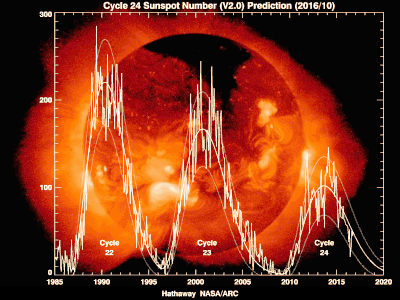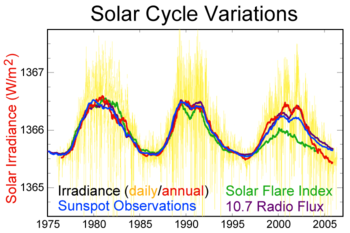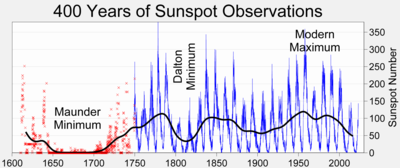From Wikipedia, the free encyclopedia

"The current prediction for Sunspot Cycle 24 gives a smoothed sunspot number maximum of about 69 in the late Summer of 2013. The smoothed sunspot number reached 68.9 in August 2013 so the official maximum will be at least this high. The smoothed sunspot number has been rising again towards this second peak over the last five months and has now surpassed the level of the first peak (66.9 in February 2012). Many cycles are double peaked but this is the first in which the second peak in sunspot number was larger than the first. We are currently over five years into Cycle 24. The current predicted and observed size makes this the smallest sunspot cycle since Cycle 14 which had a maximum of 64.2 in February of 1906."[1] The monthly sunspot number was still rising as of March 2014.[2]
The solar cycle (or solar magnetic activity cycle) is the periodic change in the Sun's activity (including changes in the levels of solar radiation and ejection of solar material) and appearance (visible in changes in the number of sunspots, flares, and other visible manifestations). Solar cycles have an average duration of about 11 years. They have been observed (by changes in the sun's appearance and by changes seen on Earth, such as auroras) for hundreds of years.
Solar variation causes changes in space weather, weather, and climate on Earth. It causes a periodic change in the amount of irradiation from the Sun that is experienced on Earth.
It is one component of solar variation, the other being aperiodic fluctuations.
Powered by a hydromagnetic dynamo process, driven by the inductive action of internal solar flows, the solar cycle:
- Structures the Sun's atmosphere, its corona and the wind;
- Modulates the solar irradiance;
- Modulates the flux of short-wavelength solar radiation, from ultraviolet to X-ray;
- Modulates the occurrence frequency of solar flares, coronal mass ejections, and other geoeffective solar eruptive phenomena;
- Indirectly modulates the flux of high-energy galactic cosmic rays entering the solar system.
History
The solar cycle was discovered in 1843 by Samuel Heinrich Schwabe, who after 17 years of observations noticed a periodic variation in the average number of sunspots seen from year to year on the solar disk.[3] Rudolf Wolf compiled and studied these and other observations, reconstructing the cycle back to 1745, eventually pushing these reconstructions to the earliest observations of sunspots by Galileo and contemporaries in the early seventeenth century. Starting with Wolf, solar astronomers have found it useful to define a standard sunspot number index, which continues to be used today.
Until recently it was thought that there were 28 cycles in the 309 years between 1699 and 2008, giving an average length of 11.04 years, but recent research has showed that the longest of these (1784–1799) seems actually to have been two cycles,[4][5] so that the average length is only around 10.66 years. Cycles as short as 9 years and as long as 14 years have been observed, and in the double cycle of 1784-1799 one of the two component cycles had to be less than 8 years in length. Significant variations in amplitude also occur. Solar maximum and solar minimum refer respectively to epochs of maximum and minimum sunspot counts. Individual sunspot cycles are partitioned from one minimum to the next.
Following the numbering scheme established by Wolf, the 1755–1766 cycle is traditionally numbered "1". The period between 1645 and 1715, a time during which very few sunspots were observed, is a real feature, as opposed to an artifact due to missing data.[6] This epoch is now known as the Maunder minimum, after Edward Walter Maunder, who extensively researched this peculiar event, first noted by Gustav Spörer. In the second half of the nineteenth century it was also noted (independently) by Richard Carrington and by Spörer that as the cycle progresses, sunspots appear first at mid-latitudes, and then closer and closer to the equator until solar minimum is reached. This pattern is best visualized in the form of the so-called butterfly diagram, first constructed by the husband-wife team of E. Walter and Annie Maunder in the early twentieth century (see graph below). Images of the Sun are divided into latitudinal strips, and the monthly-averaged fractional surface of sunspots calculated. This is plotted vertically as a color-coded bar, and the process is repeated month after month to produce this time-latitude diagram.
The physical basis of the solar cycle was elucidated in the early twentieth century by George Ellery Hale and collaborators, who in 1908 showed that sunspots were strongly magnetized (this was the first detection of magnetic fields outside the Earth), and in 1919 went on to show that the magnetic polarity of sunspot pairs:
- Is always the same in a given solar hemisphere throughout a given sunspot cycle;
- Is opposite across hemispheres throughout a cycle;
- Reverses itself in both hemispheres from one sunspot cycle to the next.
Half a century later, the father-and-son team of Harold Babcock and Horace Babcock showed that the solar surface is magnetized even outside of sunspots; that this weaker magnetic field is to first order a dipole; and that this dipole also undergoes polarity reversals with the same period as the sunspot cycle (see graph below). These various observations established that the solar cycle is a spatiotemporal magnetic process unfolding over the Sun as a whole.

Time vs. solar latitude diagram of the radial component of the solar magnetic field, averaged over successive solar rotation. The "butterfly" signature of sunspots is clearly visible at low latitudes. Diagram constructed (and regularly updated) by the solar group at NASA Marshall Space Flight Center.
Phenomena, measurement, and causes
Spots from two adjacent cycles can co-exist for some time, and since it was discovered that the Sun reverses magnetic polarity from one solar cycle to the next, spots from different cycles can be distinguished by direction of their magnetic field. However, it takes some months before a definite decision can be made as to the true date of solar minimum. One of the principal authorities that determine the date of the solar minimum is SIDC (the Solar Influences Data Analysis Center), which is located in Belgium and works with agencies such as NASA and ESA.The most important information today comes from SOHO (a project of international cooperation between ESA and NASA), such as the MDI magnetogram, where the solar "surface" magnetic field can be seen.
The basic causes of the solar variability and its cycles are still under debate, with some researchers suggesting a link with the tidal forces due to the gas giants Jupiter and Saturn,[7][8] or due to the solar inertial motion.[9][10] Another cause of Sun spots can be solar jet stream "torsional oscillation".
Patterns have been noted in solar cycles. For example, the Waldmeier effect is the phenomenon that cycles with larger maximum amplitudes tend to take less time to reach their maxima than cycles with smaller amplitudes;[11] there is also a negative correlation between maximum amplitudes and the lengths of earlier cycles, which allows a degree of prediction.[12]
Effects of the solar cycle

Activity cycles 21, 22 and 23 seen in sunspot number index, TSI, 10.7cm radio flux, and flare index. The vertical scales for each quantity have been adjusted to permit overplotting on the same vertical axis as TSI. Temporal variations of all quantities are tightly locked in phase, but the degree of correlation in amplitudes is variable to some degree.
The Sun's magnetic field structures its atmosphere and outer layers all the way through the corona and into the solar wind. Its spatiotemporal variations lead to a host of phenomena collectively known as solar activity. All of solar activity is strongly modulated by the solar magnetic cycle, since the latter serves as the energy source and dynamical engine for the former.
Surface magnetism
Sunspots may exist anywhere from a few days to a few months, but they eventually decay, and this releases magnetic flux in the solar photosphere. This magnetic field is dispersed and churned by turbulent convection, and solar large-scale flows. These transport mechanisms lead to the accumulation of the magnetized decay products at high solar latitudes, eventually reversing the polarity of the polar fields (notice how the blue and yellow fields reverse in the graph above).The dipolar component of the solar magnetic field is observed to reverse polarity around the time of solar maximum, and reaches peak strength at the solar minimum. Sunspots, on the other hand, are produced from a strong toroidal (longitudinally directed) magnetic field within the solar interior. Physically, the solar cycle can be thought of as a regenerative loop where the toroidal component produces a poloidal field, which later produces a new toroidal component of sign such as to reverse the polarity of the original toroidal field, which then produces a new poloidal component of reversed polarity, and so on.
Total solar irradiance
The total solar irradiance (TSI) is the amount of solar radiative energy incident on the Earth's upper atmosphere. TSI variations were undetectable until satellite observations began in late 1978. A series of radiometers carried on satellites from the 1970s to the 2000s.[13] TSI differed from 1360 to 1370 W/m2 across ten satellites. The controversial 1989-1991 “ACRIM gap” between non-overlapping satellites has been interpolated by an ACRIM composite showing +0.037%/decade rise by the ACRIM group, and a PMOD composite with a -0.008%/decade downward trend by the PMOD group.[14] This 0.045%/decade difference strongly impacts climate models.Satellite measurements show that solar irradiance varies systematically over the 11-year sunspot cycle,[15] both in total irradiance and in the relative components of the irradiance (UV Light ratios to Visible Light Ratios). The solar luminosity is about 0.07 percent brighter during solar maximum than during solar minimum. Photospheric magnetism appears to be the primary cause (96%) of 1996-2013 TSI variation.[16] Observations from spacecraft in the 2000s showed that the ratio of ultraviolet to visible light is much more variable than previously thought.[17]
The major finding of satellite observations is that TSI varies in phase with the solar magnetic activity cycle[18] with an amplitude of about 0.1% and an average value of about 1361.5 W/m2[19] (the "solar constant"). Variations about the average up to −0.3% are caused by large sunspot groups and of +0.05% by large faculae and bright network on a week to 10-day timescale[20] (see TSI variation graphics).[21] TSI variations over the several decades of continuous satellite observation show small but detectable trends.[22][23]
TSI is higher at solar maximum, even though sunspots are darker (cooler) than the average photosphere. This is caused by magnetized structures other than sunspots during solar maxima, such as faculae and active elements of the "bright" network, that are brighter (hotter) than the average photosphere. They collectively overcompensate for the irradiance deficit associated with the cooler but less numerous sunspots. The primary driver of TSI changes on solar rotational and sunspot cycle timescales is the varying photospheric coverage of these radiatively active solar magnetic structures.
Short-wavelength radiation
With a temperature of 5870 kelvins, the photosphere of the Sun emits a very small proportion of radiation in the extreme ultraviolet (EUV) and above. However, hotter upper layers of the Sun's atmosphere (chromosphere and corona) emit more short-wavelength radiation. Since the upper atmosphere is not homogeneous and contains significant magnetic structure, the solar ultraviolet (UV), EUV and X-ray flux varies markedly in the course of the solar cycle.
The photo montage to the left illustrates this variation for soft X-ray, as observed by the Japanese satellite Yohkoh from after August 30, 1991, at the peak of cycle 22, to September 6, 2001, at the peak of cycle 23. Similar cycle-related variations are observed in the flux of solar UV or EUV radiation, as observed, for example, by the SOHO or TRACE satellites.
Even though it only accounts for a minuscule fraction of total solar radiation, the impact of solar UV, EUV and X-ray radiation on the Earth's upper atmosphere is profound. Solar UV flux is a major driver of stratospheric chemistry, and increases in ionizing radiation significantly affect ionosphere-influenced temperature and electrical conductivity.
Solar radio flux
Emission from the Sun at centimetric (radio) wavelength is due primarily to coronal plasma trapped in the magnetic fields overlying active regions.[24] The F10.7 index is a measure of the solar radio flux per unit frequency at a wavelength of 10.7 cm, near the peak of the observed solar radio emission. F10.7 is often expressed in SFU or solar flux units (1 SFU = 10−22 W m−2 Hz−1). It represents a measure of diffuse, nonradiative heating of the coronal plasma trapped by magnetic fields over active regions. It is an excellent indicator of overall solar activity levels and correlates well with solar UV emissions.The solar F10.7 index is measured daily at local noon in a bandwidth of 100 MHz centered on 2800 MHz at the Penticton site of the Dominion Radio Astrophysical Observatory (DRAO), Canada. The solar F10.7 cm record extends back to 1947, and is the longest direct record of solar activity available, other than sunspot-related quantities.[25][26]
Sunspot activity has a major effect on long distance radio communications particularly on the shortwave bands although medium wave and low VHF frequencies are also affected. High levels of sunspot activity lead to improved signal propagation on higher frequency bands, although they also increase the levels of solar noise and ionospheric disturbances. These effects are caused by impact of the increased level of solar radiation on the ionosphere.
It has been suggested that 10.7 cm solar flux could interfere with point-to-point terrestrial communications.[27]
Geoeffective eruptive phenomena

An overview of three solar cycles shows the relationship between the sunspot cycle, galactic cosmic rays, and the state of our near-space environment.[28]
The solar magnetic field structures the corona, giving it its characteristic shape visible at times of solar eclipses. Complex coronal magnetic field structures evolve in response to fluid motions at the solar surface, and emergence of magnetic flux produced by dynamo action in the solar interior. For reasons not yet understood in detail, sometimes these structures lose stability, leading to coronal mass ejections into interplanetary space, or flares, caused by sudden localized release of magnetic energy driving copious emission of ultraviolet and X-ray radiation as well as energetic particles. These eruptive phenomena can have a significant impact on Earth's upper atmosphere and space environment, and are the primary drivers of what is now called space weather.
The occurrence frequency of coronal mass ejections and flares is strongly modulated by the solar activity cycle. Flares of any given size are some 50 times more frequent at solar maximum than at minimum. Large coronal mass ejections occur on average a few times a day at solar maximum, down to one every few days at solar minimum. The size of these events themselves does not depend sensitively on the phase of the solar cycle. A good recent case in point are the three large X-class flares having occurred in December 2006, very near solar minimum; one of these (an X9.0 flare on Dec 5) stands as one of the brightest on record.[29]
Cosmic ray flux
The outward expansion of solar ejecta into interplanetary space provides overdensities of plasma that are efficient at scattering high-energy cosmic rays entering the solar system from elsewhere in the galaxy. Since the frequency of solar eruptive events is strongly modulated by the solar cycle, the degree of cosmic ray scattering in the outer solar system varies in step. As a consequence, the cosmic ray flux in the inner solar system is anticorrelated with the overall level of solar activity. This anticorrelation is clearly detected in cosmic ray flux measurements at the Earth's surface.Some high-energy cosmic rays entering Earth's atmosphere collide hard enough with molecular atmospheric constituents to cause occasionally nuclear spallation reactions. Some of the fission products include radionuclides such as 14C and 10Be, which settle down on Earth's surface. Their concentration can be measured in ice cores, allowing a reconstruction of solar activity levels into the distant past.[30] Such reconstructions indicate that the overall level of solar activity since the middle of the twentieth century stands amongst the highest of the past 10,000 years, and that Maunder minimum-like epochs of suppressed activity, of varying durations have occurred repeatedly over that time span.
Effects on Earth
Terrestrial organisms
The impact of the solar cycle on living organisms has been investigated (see chronobiology). Some researchers claim to have found connections with human health.[31][32]The amount of ultraviolet UVB light at 300 nm reaching the Earth varies by as much as 400% over the solar cycle due to variations in the protective ozone layer. In the stratosphere, ozone is continuously regenerated by the splitting of O2 molecules by ultraviolet light. During a solar minimum, the decrease in ultraviolet light received from the Sun leads to a decrease in the concentration of ozone, allowing increased UVB to penetrate to the Earth's surface.[33]
Radio communication
Skywave modes of radio communication operate by bending (refracting) radio waves (electromagnetic radiation) through the Ionosphere. During the "peaks" of the solar cycle, the ionosphere becomes increasingly ionized by solar photons and cosmic rays. This affects the path (propagation) of the radio wave in complex ways which can either facilitate or hinder local and long distance communications. Forecasting of skywave modes is of considerable interest to commercial marine and aircraft communications, amateur radio operators, and shortwave broadcasters.
These users utilize frequencies within the High Frequency or 'HF' radio spectrum which are most affected by these solar and ionospheric variances. Changes in solar output affect the maximum usable frequency, a limit on the highest frequency usable for communications.
Early research attempted to find a correlation between weather and sunspot activity, mostly without notable success.[35] Later research has concentrated more on correlating solar activity with global temperature. Most recently, research suggests that there may also be regional climate impacts due to the solar cycle. Measurements from the Spectral Irradiance Monitor on NASA’s Solar Radiation and Climate Experiment show that solar UV output is more variable over the course of the solar cycle than scientists had previously thought, resulting in, for example, colder winters in the US and southern Europe and warmer winters in Canada and northern Europe during solar minima.[36]
There are three suggested mechanisms by which solar variations are hypothesized to have an effect on climate:
The effect of solar variation at time scales longer than a solar cycle is also of interest to climate science. The current scientific consensus is that solar variations do not play a major role in determining present-day global warming,[34] since the measured magnitude of recent solar variation is much smaller than the forcing due to greenhouse gases,[41] but the level of understanding of solar impacts is low.[42]
If astronauts on a space mission are above the shielding effect produced by the Earth's magnetic field, the radiation from a CME would also be dangerous to humans; many future mission designs (e.g., for a Mars Mission) therefore incorporate a radiation-shielded "storm shelter" for astronauts to retreat to during such a radiation event.
In view of the problems in space flight occurring during high solar activity, prediction of the latter becomes more and more important. A particular method that relies on several consecutive cycles was established by Wolfgang Gleißberg.[43]
Terrestrial climate
Both long-term and short-term variations in solar activity are hypothesized to affect global climate, but it has proven extremely challenging to directly quantify the link between solar variation and the earth’s climate.[34] The topic continues to be a subject of active study.Early research attempted to find a correlation between weather and sunspot activity, mostly without notable success.[35] Later research has concentrated more on correlating solar activity with global temperature. Most recently, research suggests that there may also be regional climate impacts due to the solar cycle. Measurements from the Spectral Irradiance Monitor on NASA’s Solar Radiation and Climate Experiment show that solar UV output is more variable over the course of the solar cycle than scientists had previously thought, resulting in, for example, colder winters in the US and southern Europe and warmer winters in Canada and northern Europe during solar minima.[36]
There are three suggested mechanisms by which solar variations are hypothesized to have an effect on climate:
- Solar irradiance changes directly affecting the climate ("Radiative forcing").
- Variations in the ultraviolet component. The UV component varies by more than the total, so if UV were for some (as yet unknown) reason having a disproportionate effect, this might cause an effect on climate.
- Effects mediated by changes in cosmic rays (which are affected by the solar wind) such as changes in cloud cover.
The effect of solar variation at time scales longer than a solar cycle is also of interest to climate science. The current scientific consensus is that solar variations do not play a major role in determining present-day global warming,[34] since the measured magnitude of recent solar variation is much smaller than the forcing due to greenhouse gases,[41] but the level of understanding of solar impacts is low.[42]
Effects on spacecraft
The coronal mass ejections ("CME") associated with solar flares produces a radiation flux of high-energy protons, sometimes known as solar cosmic rays. These can cause radiation damage to electronics and solar cells in satellites. The solar proton events also can cause single-event upset (SEU) events on electronics; at the same, the reduced flux of galactic cosmic radiation during solar maximum (see section "Cosmic ray flux" above) will decrease the high-energy component of particle flux.If astronauts on a space mission are above the shielding effect produced by the Earth's magnetic field, the radiation from a CME would also be dangerous to humans; many future mission designs (e.g., for a Mars Mission) therefore incorporate a radiation-shielded "storm shelter" for astronauts to retreat to during such a radiation event.
In view of the problems in space flight occurring during high solar activity, prediction of the latter becomes more and more important. A particular method that relies on several consecutive cycles was established by Wolfgang Gleißberg.[43]







